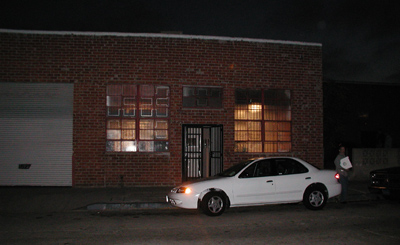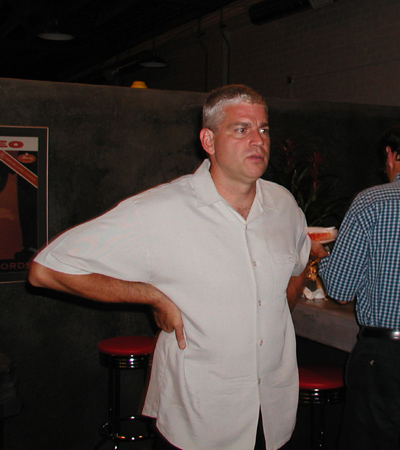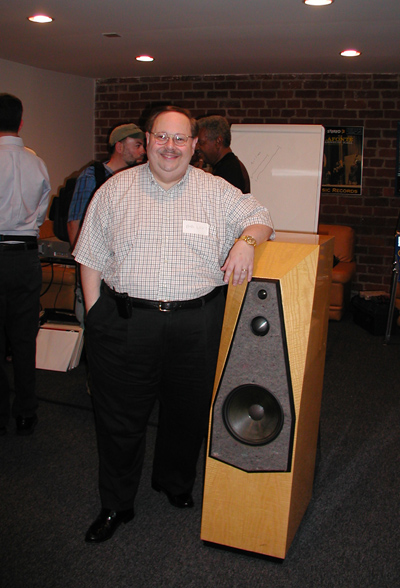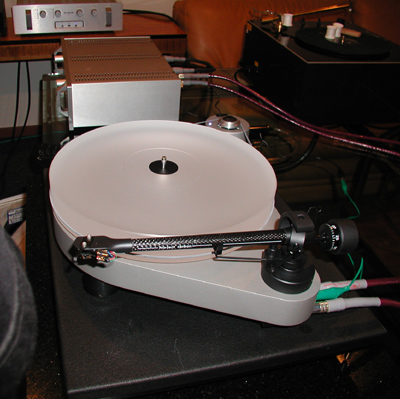|
You are reading the older HTML site Positive Feedback ISSUE 8 august/september 2003 An Evening at Classic Records in Hollywood, CA.
Just a few blocks from the theatre where the Academy Awards are annually bestowed, in the heart of LA's historic entertainment center, near the star laden walk of fame, and within the very same building used to house the freshly minted RCA Living Stereo LP's from the 1950's, a group of some 40 audiophiles from the Greater South Bay Audio Society were treated to the inauguration of the new home of Classic Records. What an evening it was!
Classic Records, now 10 years old and going strong, renovated the original RCA warehouse to its jewel-like origins. Completely redone and masterfully appointed, it features ample shelving and storage for all of Classic's inventory and its archive. Beautiful office space with plenty of future expansion capability is located just across the building. In addition to loading docks and many amenities, is a generous sound room equipped with Avalon speakers, ARC 200 VT stereo amp, Plinius Preamp and phono stages, state of the art turntables, Muse 10 Digital front end for DAD, and wired with Cardas top of the line balanced interconnects and speaker cables. In addition to seating for 40, a selection of pinball machines were placed behind the system to entertain while the sixteen 6550 output tubes in the VT 200 became warm. I believe that heaven might be described by an audiophile as some place like this.
In the 50's, the RCA pressing plant was located just next door, and the freshly pressed and packaged albums made their way through large side doors to the shelving within the now Classic facility. After welcoming all, Michael Hobson, President and founder, told the assembled audio conoschenti, about his vision for the company. His frank desire is to make the finest LP's that can be made on the planet and to create digital software with the utmost care and attention to detail; all to provide a truly pleasurable listening experience for the consumer. An extraordinary demonstration about the technical improvements in LP production then followed.
Played first was the "sunrise" on the original RCA Living Stereo, Also Sprach, conducted by Reiner, recorded in 1954…a pristine original copy sells in the open market at about $500. It was used as a reference for Classic in pressing the new editions. It sounded very good and musical, but restrained and only moderately ambient with good depth. The surface was rather noisy. Next up was the first reissue of the album in 1994 by Classic on the best possible vinyl and with the utmost care available then. It sounded easily 50% better in all respects. Increased dynamics, more like the master tape sound, quieter, and more realistic were just a few of the comments of the crowd assembled. The third example from 1997 used an improved vinyl formulation called by Classic "SV" and was issued at 33.3 rpm. The sound really popped on this version, clearly 75% better than the RCA original in all ways. The higher SN ratio and the increased definition and musicality was unmistakable. The fourth example recently released at 33.3 on the new flat profile [more on this in a minute] and SVP vinyl…the best 33.3 format yet developed and exclusive to Classic Records, was startling. It was 100% better than the original and elicited gasps from those assembled. It may not have been reality, but it was so close one would think 100 musicians had been crammed into the room. The original version from 1954, if auctioned at that point in the evening to the gathered audiophiles, would have gone for $50 not $500. Then Michael prepared us for the ultimate vinyl demonstration. When the 33.3 was transcribed, Bernie Grundman also transcribed a 45 rpm version. This 45 rpm version was released incorporating flat profile and "SVP" and water from the fountain of youth… just kidding on the water. The 45 rpm LP was placed on the turntable in total silence as the gathered assembly clutched the edges of their chairs. No one was breathing as the stylus touched the first groove. From the ultra black background emerged the 30 hz rumble of the double basses, without any sort of apparent compression, followed by horns and tympany that exploded in waves from back to front, as the melody richly and musically immersed the listeners. Music was wall to wall and ceiling to floor. This was, I'd say, 200% better than the original and, frankly, just plain astounding! So what was happening here. Classic has auditioned and discovered a better vinyl formulation twice in its short history. The latest "SVP" formulation has the best SN ratio and innate musical ability of any formulation ever made. Then came a breakthrough. While mastering 1950's Blue Note records, Michael discovered they had no outer lip/groove guard. The outer lip was placed there in the mid-fifties to help record changers work better with stacked LP's. To get an outer lip and a raised label in the center, the record playing surface was made convex. That's right, records are not flat…except for the very center grooves. That's ALL records made today by everyone in the business EXCEPT Classic Records. What's most astounding is all the record parts, the laquer, the mother, etc. are all flat. The curving is done by the stamper by purposely bending the dye in the final stages of pressing. Classic has exclusivity over the new process at RTI for pressing flat records without an outer lip and with startlingly better LP sound start to finish. Whew! There is something new under the LP sun and it's a pressing technique that's 50 years old. Bravo, Michael. We did not hear any master tapes, but Michael says they do not sound like an LP. The LP, says he, is additive, and in many ways is more musical with better sound. Though digital formats sound more like the master tape, they are not as musical as vinyl. LP's unlike CD's or SACD's, etc., are the only format that contains 100% of the recorded signal uncompressed. All digital media are compressed and details are sampled in bits. Some of the music is missing. In LP's, none of it is missing. I can tell you that the SVP vinyl plus flat profile at 45 rpm tells my ears that Reiner paid us a visit tonight via an LP time machine.
Then it was Jim Alexander's turn. Jim is Technical Director of Sumiko who graced us with his latest inventions. His goal was to design a $2000 phono player front end that is clearly high end. He feels that the $30,000 SME 20 is the best on the planet. But if one cannot design a player for $30,000, he should be ashamed of himself. Jim's RM9 Pro-Ject turntable, carbon fiber arm, and new $750 Sumiko MC Cartridge…all totaling $2000…sounded first rate. There are 3 types of tables.
Each has its benefits and problems, but the RM9 is type 1. So is the new VPI Scout and a number of new great sounding less expensive designs. The popular VPI HW19-3&4 are type 2. The new VPI Anniversary and the SME 20 are type 3. There are 4 types of tone arms.
The Sumiko Carbon Fiber arm is type 3. The Souther and historic Rabco are examples of a type 1. The VPI arms are all type 2 as are the Graham. The old SME 3009 is a knife edge design, but this design is no longer in production. New SME's are type 2.
Cartridges are all MM or MC and use magnets or coils, respectively. The Sumiko is an MC design. The Grado's are all MM designs. With less mass, the MC's are usually more detailed, but harder to design. The life expectancy for phono cartridges is 5-6 years. This has nothing to do with the stylus which lasts indefinitely. The inner parts decay over time and you lose bass and definition. The decay is gradual so best to replace in this time frame. There is no fix for this and retipping does not help. Cartridges are like beer…best consumed immediately and kept fresh for best results. Meeting Jim was an intellectual treat for all…we even discussed the new laser pick up turntable/tone arm coming out soon for $10,000 by an unnamed European company. Jim was fascinating on this. The best laser [wavelength] is not as small as the smallest groove etched information on records by one-third. Therefore, a laser will only track about two-thirds of the groove information or music on LP's…not good. A diamond stylus, says he, will theoretically get it all. We all just saved a bunch of dough. The evening ended with a private dinner where Michael spoke about his newest project: a digital disk format to replace the DAD. It will be a disk with DAD on one side at 24/96 and DVD-A on the other side at 24/192. The DAD will play on any DVD Video player in America and the DVD-A will be there should one acquire a DVD-A player or omni format player. This makes the Classic software very consumer friendly. Look for announcements soon from Classic about this new way of releasing music on disk and, of course, more great LP releases to be issued in the months ahead. An evening of HI FI just doesn't get much better than this!
|








